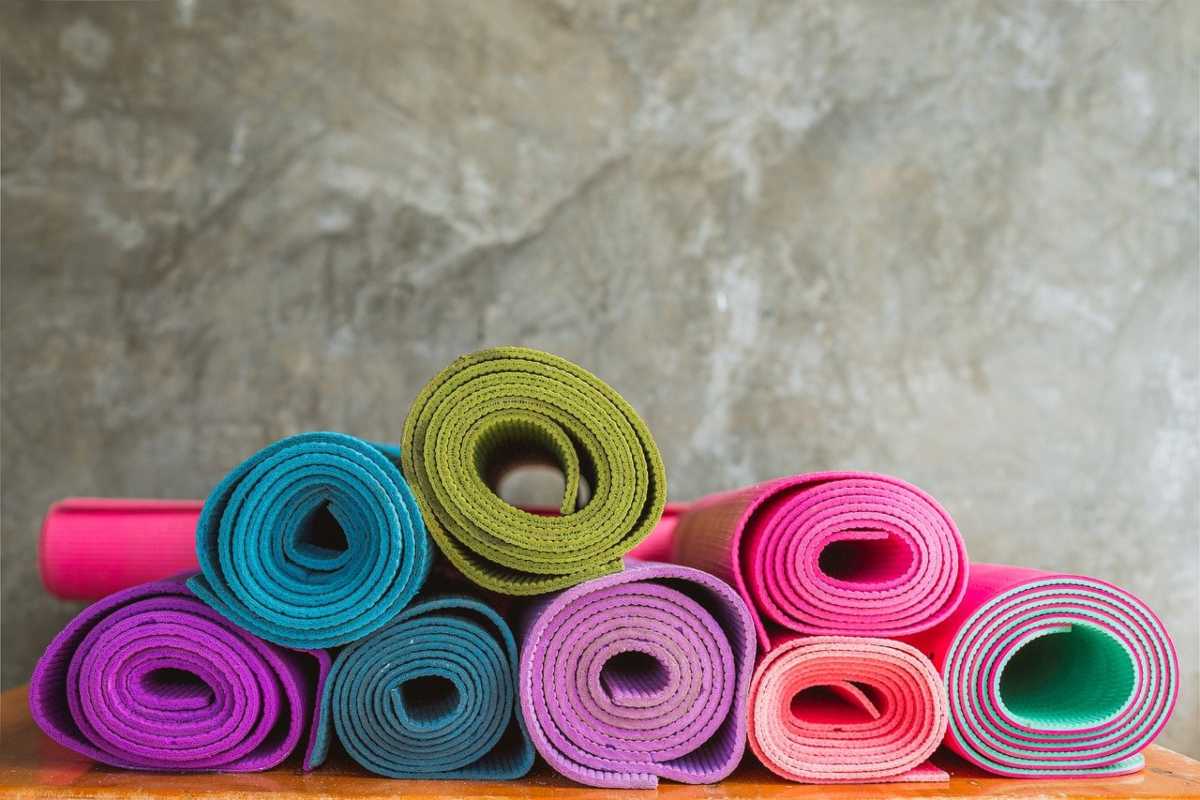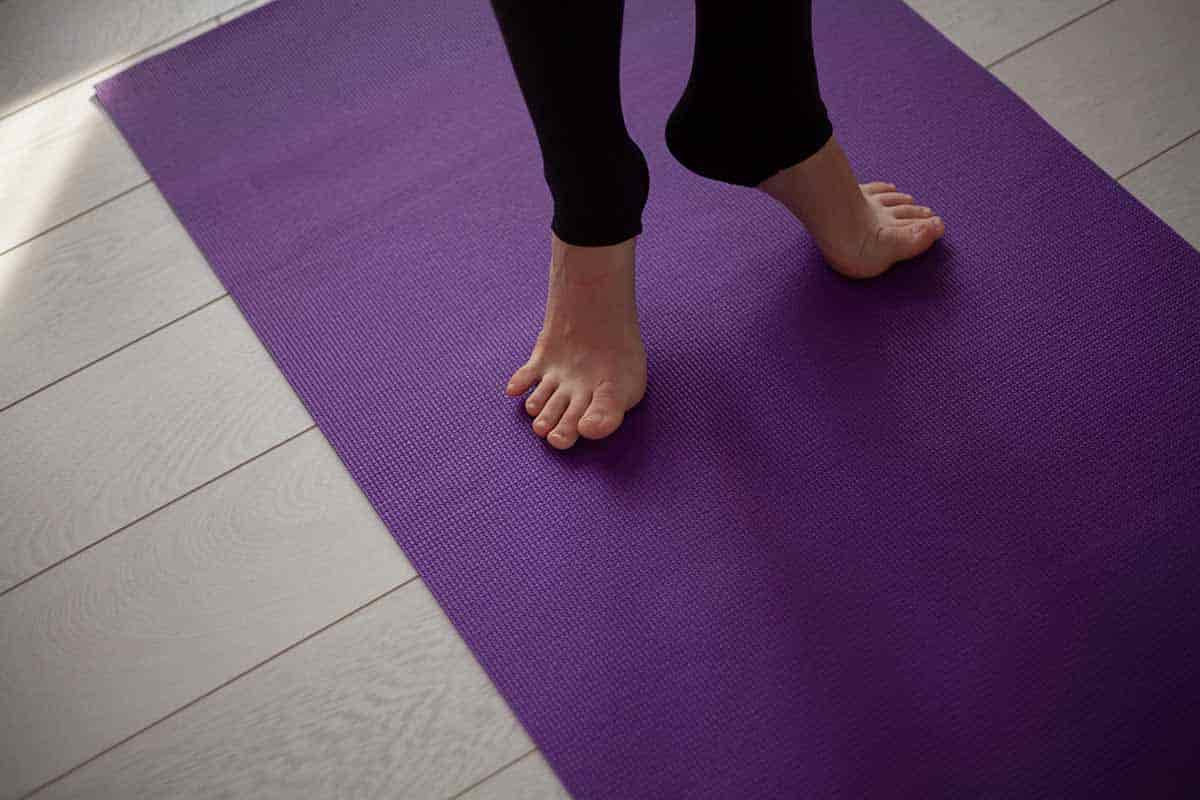
oga mats are great tools for people that want to work out on the floor. The material yoga mats are made of allows you to be in various positions on any floor surface without being comfortable or causing damage to your joints. While some materials may absorb pressure better, most yoga mats will achieve the same level of comfort.
Yoga mats can be made from any material you really want however, usually, they are made from a blend of stuff to create a nice cushioned mat. Some types of materials yoga mats are made out of are:
- Foam
- Vinyl
- Rubber
- Cotton
- PVC
(Source: Very Well Fit, Leaf Score)
Whether you are shopping for yoga mats based on sustainability, budget, or comfort, there is absolutely a yoga mat out there that is perfect for you. The large variety of different materials make it almost impossible for you to not find the kind of mat that you want.
Article Topics
What Type Of Foam Are Yoga Mats Made From?
When looking at foam yoga mats, you need to know what it’s truly made from. The foam is made from rubber or plastic, chemically altered to create the material we call foam. Other synthetic materials are mixed in, but these small amounts don’t bother the overall composition.
The only reason you need to know what type of foam your yoga mat is made form is when looking to recycle it. If your mat is made from rubber, they can ground it up and made another one however, plastic foam is almost impossible to recycle, so you would be better upcycling it.
What Material Is Best For A Yoga Mat?
Finding the best material for a yoga mat depends highly on the useability and your personal preferences. Every different material used to make yoga mats has specific purposes that allow for a different kind of activity.
Durability Among Materials
The biggest thing to pay attention to when figuring out the best yoga mat to get is how durable the material is. If you are wanting your yoga mat to last a long time without needing to be replaced, you will want to look at a PVC or plastic-type material. Plastic-made yoga mats can last upwards of 10 years if you take care of them well.
Rubber and vinyl-type yoga mats are durable but not nearly as much as PVC, and most are recyclable. They can last upwards of 5-7 years when taken care of well but can break down easily if kept in rough conditions.
Naturally-made yoga mats are usually composed of things like cotton or jute and are often thinner than other yoga mats. They often don’t last longer than 3-5 years but are highly sustainable and can usually be recycled.
(Source: Yoga Accessories, Alexa Larryngton)
3 Most Common Yoga Mat Material Types
Now, yoga mats are mass-produced in most areas, so this means that more than half of yoga mats are generally similar in make-up and composition. If you are purchasing yoga mats from chain stores, you will most likely be purchasing a mat with the more commonly used materials.
If you were to search for lesser-known small stores or independent businesses, you might find more unique yoga mat compositions or natural fiber compositions. Some materials are great for the environment and rough on the budget, or vice versa.
PVC
One of the most inexpensive options when being mass-produced, PVC creates a foam-like texture that helps grip the floor and gives you a cushion against hard surfaces. This is the most common type of yoga mat material you will find due to its ability to be very versatile.
PVC is extremely durable and can last over a decade when taken care of well, but it does have a few drawbacks. PVC can get slippery when wet, so if you are sweating, you risk slipping on your mat.
Unfortunately, PVC is also extremely dangerous to the environment and can end up being in a landfill for several decades before it starts to break down. This usually means hundreds of thousands of yoga mats are in landfills due to their inability to be recycled.
Since it is synthetically made, which allows them to be budget-friendly and easy to pack and carry due to their lightweight, if you are just starting out with yoga mats, this is a great material to purchase without feeling like you are making a huge commitment.
Thermoplastic Elastomers
Thermoplastic Elastomers or TPE is a much better option for yoga mats than PVC. TPE is almost always recyclable, it doesn’t require reinforcing agents to help it hold its shape, and this makes it less dangerous to you and the earth in general.
TPE can break down quicker than PVC, and it doesn’t leave behind toxic chemicals after it has broken down. It is lightweight, durable, and has a good amount of cushion to help support painful joints during certain poses.
TPE is also resistant to bacterial issues due to its closed-cell properties, as well as being resistant to water and oil. This keeps your mat from breaking down prematurely and helping you get by without cleaning it as often as it needs without damaging it.
(Source: REI, Alexa Larryngton)
Natural/Organic Fibers
Yoga mats can be made of natural materials that are far better for the environment both during production and once they are done being used. Natural yoga mats can be made of any material that is naturally occurring and sustainable.
Some options for natural fibers to make yoga mats with are:
- Wool
- Cork
- Natural Rubber
- Cotton
- Jute
Wanting yoga mats made with natural fibers is a fantastic way to help sustain the environment while diving deep into your hobby. The only difference in production that natural fibers have from artificial materials is that natural and organic fibers usually have to have two layers to help with anti-slip protection.
(Source: livi Yoga, yoga signs)
| Type Of Material | Pros | Cons |
|---|---|---|
| PVC | ● Extremely high durability ● Budget-Friendly ● Anti-slip ● Anti-bacterial ● Lightweight | ● Bad for the environment ● Non-recyclable ● Toxic to nature/humans |
| TPE | ● Still budget-friendly ● Waterproof ● Better for the environment than PVC ● Anti-bacterial ● DOes cause toxic chemicals when broken down | ● It takes a while to breakdown ● DIfficult to find a recycling center |
| Natural/Organic | ● Biodegradable ● Made from sustainable sources ● Variety of material options ● Customize to your desire | ● Natural fibers can cause allergic reactions ● More expensive than artificial materials ● Can slip and move with the movement |
Final Thoughts
Yoga is a fantastic tool to help relieve stress, joint issues, and overall body health problems. The issue most people have with yoga is the expense of the yoga mats that are a crucial part of the exercise art.
While cheap yoga mats aren’t the greatest decision, you are still able to find budget-friendly mats that allow for plenty of variety in your yoga routine without too much upkeep on your end. Research for your specific needs and desires, and you should find the perfect fit in no time.



